The Spiralizer is taking the fresh produce aisle by storm and rightfully so. However, a college budget and mini fridge does not always lend itself to intricate dishes. With just five ingredients, any college cook can transform fruits and vegetables into fresh noodles. This recipe template incorporates the Spiralizer into simple and satisfying meals.
Check out the Spiralizer recipe template below. Each recipe requires only a portion of the ingredients, so use the extra kale later in the week and save the nuts for the entire semester.
Spiralized Vegetables Recipe Template
Spiralized Vegetable + Vegetable Add-In #1 + Vegetable Add-In #2 + Protein/Grains + Topping
Suggested Combinations:
- Zuchinni noodles with kale, tomatoes, walnuts and red pepper flakes
- Sweet potato noodles with kale, broccoli, quinoa and salt and pepper
- Apple noodles with mixed berries, Greek yogurt, almonds and honey
Step 1: Spiralized Vegetable
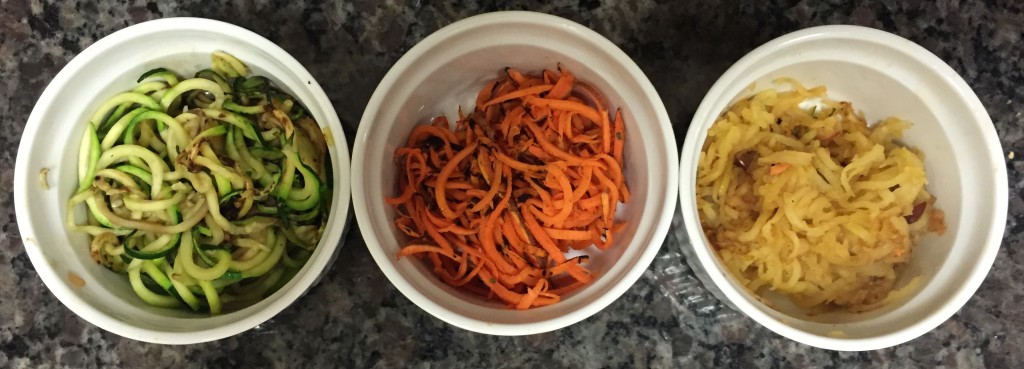
Photo by Christina Warner
Ingredients: Zucchini, sweet potato, apple
Start with a solid Spiralizer. I prefer the OXO Good Grip Hand-Held Spiralizer because it’s small, convenient and works well.
First, wash and peel the vegetable. I left the skin on, but peel it if you prefer. Next, chop off about an inch from the bottom of the vegetable to create a flat surface. Center the vegetable on the Spiralizer and beginning spiralizing.
For more instructions on how to spiralizer check out Inspiralized.
Tip: If the vegetable does not fit into the Spiralizer, slice off the sides. Use the food holder to safely spiralize the remaining pieces.
Step 2: Vegetable Add-In #1
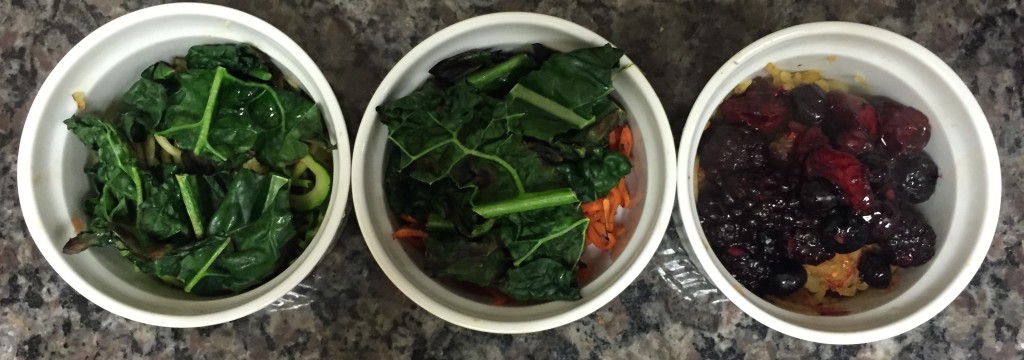
Photo by Christina Warner
Ingredients: Kale, mixed berries
After spiralizing the noodles, you can begin building the whole meal. Cook the add-in vegetables on a stovetop for about 5 minutes (as done here) or in the oven at 375°F for approximately 10 minutes. For the apple noodles, add berries.
Tip: Frozen mixed berries are less expensive than fresh berries and store for a longer time. Added bonus, they cook into a delicious berry compote on the stovetop.
Step 3: Vegetable Add-In #2
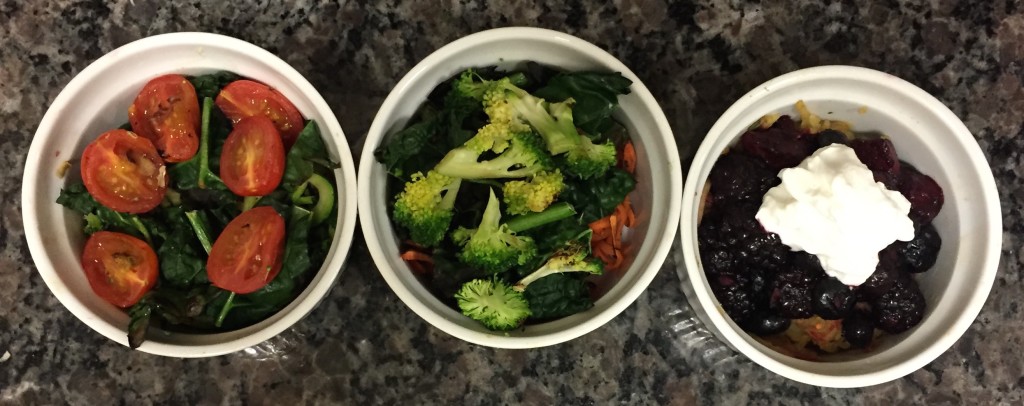
Photo by Christina Warner
Ingredients: Tomatoes, broccoli, Greek yogurt. The apple noodles use mixed berries and is a dessert dish, so yogurt takes the place of fruit in Step 3.
A third vegetable adds a whole new layer of flavor. Save some time by cooking this second vegetable add-in alongside the first vegetable topping in Step 2.
Tip: Try using fresh, uncooked vegetables. Avocado with zuchinni noodles makes a great lunch.
Step 4: Protein/Grains
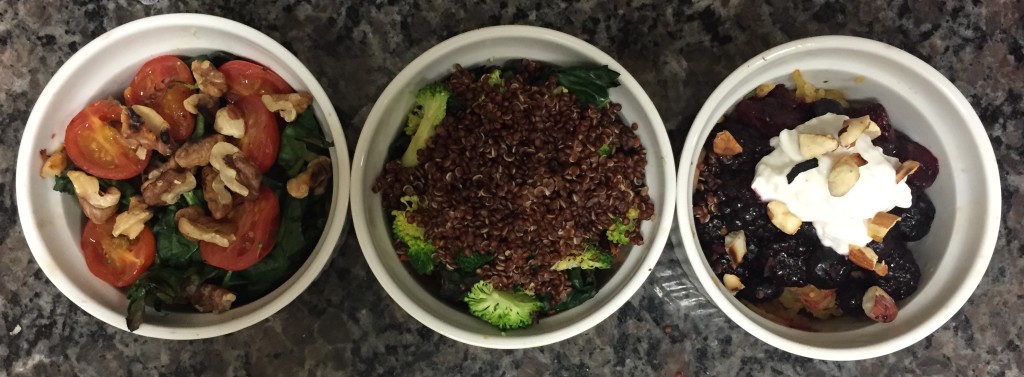
Photo by Christina Warner
Ingredients: Toasted walnuts, cooked quinoa, toasted almonds
This step is key to getting the most bang for your buck. Protein and grains add substance and transform a bowl of vegetables into a satisfying meal.
Whether its nuts, yogurt or even today’s very trendy poached egg, make sure to incorporate hearty foods into these spiralized noodle dishes. You don’t want to find yourself late-night snacking.
Tip: Prepare nuts and quinoa ahead of time. Try toasting leftover quinoa on the stovetop. The toasted quinoa adds a crispy texture to spiralized noodles.
Step 5: Toppings
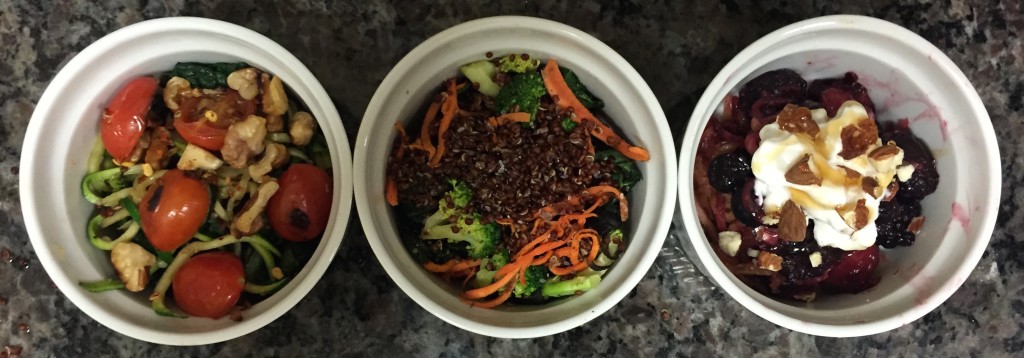
Photo by Christina Warner
Ingredients: Red pepper flakes, salt and pepper, honey
Toppings tie the ingredients together and spice up the dish. Zucchini noodles pair nicely with red pepper flakes, but salt and pepper gets the job done too. This step is all about adding what’s in the pantry, so mix it up. Try feta cheese, fresh basil or my personal favorite, Siracha.
Tip: The Spiralizer helps make a great makeshift apple crisp. Toast oats on the stovetop and use as a topping for apple noodles.
With five ingredients and a simple Spiralizer recipe template, you’re well on your way to a healthy college diet and Instagram-worthy dishes. All together these three recipes require fifteen ingredients. That’s three dinners with five ingredients and plenty of leftovers. Try mixing extra zucchini and sweet potato noodles together or incorporate other protein-packed foods on top of your noodles. Happy spiralizing!


